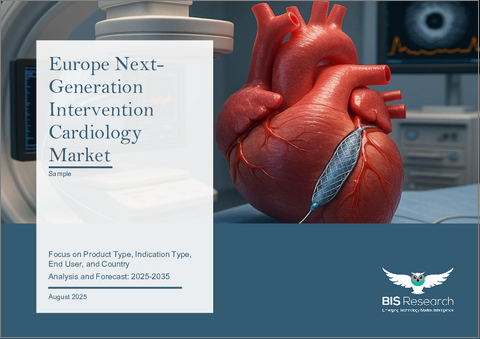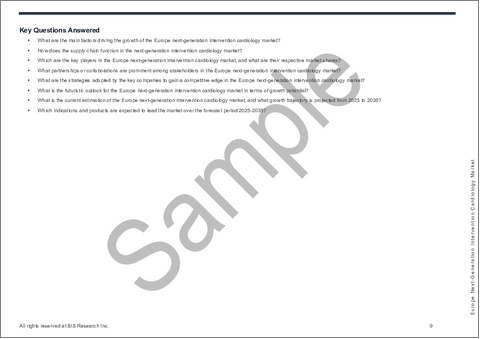|
|
市場調査レポート
商品コード
1800746
欧州の次世代インターベンションカーディオロジー市場:製品タイプ別、適応症タイプ別、エンドユーザー別、地域別 - 分析と予測(2025年~2035年)Europe Next-Generation Intervention Cardiology Market: Focus on Product Type, Indication Type, End User, and Country - Analysis and Forecast, 2025-2035 |
||||||
カスタマイズ可能
|
|||||||
| 欧州の次世代インターベンションカーディオロジー市場:製品タイプ別、適応症タイプ別、エンドユーザー別、地域別 - 分析と予測(2025年~2035年) |
|
出版日: 2025年08月30日
発行: BIS Research
ページ情報: 英文 87 Pages
納期: 1~5営業日
|
全表示
- 概要
- 図表
- 目次
欧州の次世代インターベンションカーディオロジー(インターベンション心臓病学)の市場規模は、2024年の58億10万米ドルから2035年には130億6,300万米ドルに達し、予測期間の2025年~2035年のCAGRは7.66%になると予測されています。
次世代インターベンションカーディオロジーは、弁膜症、冠動脈疾患、心臓の構造的欠陥の治療に、洗練された低侵襲で精密なガイドを用いた方法を用いることで、欧州の心臓治療に革命をもたらしています。この分野では、従来の開心術から、より安全で個別化されたカテーテルを用いた手技への変化が顕著です。ロボット工学、AIを駆使した画像処理、最先端の機器技術が欧州の医師によって統合され、手技の安全性、正確性、効率性が向上しています。患者の転帰を改善し回復期間を短縮することに加え、この開発は、最先端治療へのアクセスを増やし、病院資源を最適化し、高齢化する人口に効率的な心血管ソリューションを提供するという欧州のヘルスケア目標をサポートしています。
| 主要市場統計 | |
|---|---|
| 予測期間 | 2025年~2035年 |
| 2025年の評価 | 61億2,670万米ドル |
| 2035年の予測 | 130億6,300万米ドル |
| CAGR | 7.66% |
市場イントロダクション
欧州の次世代インターベンションカーディオロジー市場は、ヘルスケアシステムが複雑な心血管疾患を管理するための低侵襲で患者中心のソリューションを優先するようになり、急速な変貌を遂げつつあります。欧州では、冠動脈疾患、心臓の構造異常、弁膜症などの心血管疾患による罹患率や死亡率の主な原因として、カテーテルを用いた先進的な手術が開心術に取って代わる傾向が強まっています。この地域では、患者の転帰を高め、在院日数を短縮し、ヘルスケア資源を最大限に活用することに重点を置いていることが、この変化を引き起こしています。
次世代型インターベンションカーディオロジーでは、ロボット工学、AIを駆使した画像処理、3Dナビゲーション、高度な機器技術などが、精度、安全性、手技の効率性を向上させるために使用されています。欧州中のヘルスケア施設が、薬剤コーティングバルーン、生体吸収性スキャフォールド、経カテーテル大動脈弁置換術(TAVR)、経カテーテル僧帽弁修復術(TMVR)などのイノベーションを採用する割合が増加しています。これらの最先端治療の普及は、患者にとってよりアクセスしやすいハイブリッド型カテーテル検査室や外来施設の設立によってさらに後押しされています。
EUのMDR(医療機器規制)を含む規制の枠組みは、より高い安全基準と臨床的検証を強制することによって、製品の承認を形成しています。ヘルスケア投資の増加、高齢化、医療技術企業と学術機関の強力な研究開発協力も相まって、欧州は次世代インターベンションカーディオロジー技術革新と導入の重要な拠点として位置づけられています。
市場セグメンテーション
セグメンテーション1:製品タイプ別
- ロボット
- ロボット支援経皮的冠動脈インターベンション(R-PCI)
- ロボット支援冠動脈バイパス術(RA-CABG)
- ロボット支援僧帽弁置換術(RMVR)
- ロボット支援大動脈弁置換術
- ロボット以外
- IVUS
- OCT
- その他のインターベンション
- ステント
- カテーテル
- ガイドワイヤー
- PTCAバルーン
- その他
セグメンテーション2:適応症タイプ別
- 心臓構造疾患
- 冠動脈疾患
- 心臓弁膜症
- 末梢動脈疾患
- 先天性心疾患
セグメント3:エンドユーザー別
- 病院およびクリニック
- 心臓センター
- 外来手術センター
セグメント4:地域別
- 欧州
- ドイツ
- 英国
- フランス
- イタリア
- スペイン
- その他
欧州の次世代インターベンションカーディオロジー市場の動向、促進要因・課題
動向
- 次世代ステント、バルーン、カテーテルを用いた低侵襲手技の採用拡大
- 開心術に代わる経カテーテル治療(TAVR、TMVRなど)の拡大
- ロボット工学と画像誘導システムの統合別精度の向上と合併症の減少
- 薬剤コーティングバルーン、生体吸収性スキャフォールド、新規ステント材料の使用増加
- 手技計画とリアルタイムガイダンスにおけるAI、機械学習、3D画像の応用の増加
- 欧州全域における外来心臓治療センターとハイブリッド手術室の力強い成長
促進要因
- 人口の高齢化とライフスタイル要因別心血管疾患の高い有病率
- 従来の手術に比べて侵襲が少なく、回復の早い治療に対する需要の高まり
- 欧州の医療機器企業や研究機関が支援する技術革新
- 先進的な心臓治療に対するEUのヘルスケア政策と償還の枠組み
- デジタルヘルス、遠隔心臓病学、遠隔患者モニタリングへの投資の増加
- 冠動脈疾患や構造的心疾患に対する意識の高まりと早期診断
課題
- 次世代インターベンション機器やロボットシステムの高価格が、地域別のアクセスを制限しています。
- EU加盟国間の償還政策のばらつき
- 新技術を採用するインターベンションカーディオロジストに対する学習曲線とトレーニング要件の厳しさ
- CEマーキングやEU MDR適合のための規制上のハードルが製品発売を遅らせる
- 従来の手技や代替療法との競合
- 小規模病院におけるハイブリッド型カテラボのようなインフラの限られた利用可能性
製品/イノベーション戦略:当レポートは、欧州の次世代インターベンション心臓治療における最新技術の進歩に関する深い洞察を提供し、企業がイノベーションを推進し、市場のニーズに合わせた最先端の製品を開発することを可能にします。
成長/マーケティング戦略:包括的な市場分析を提供し、主要な成長機会を特定することで、企業は的を絞ったマーケティング戦略を策定し、市場でのプレゼンスを効果的に拡大するための知識を得ることができます。
競合戦略:当レポートは徹底的な競合情勢分析を含んでおり、欧州の次世代インターベンション心臓治療における競合他社の強みと弱みを理解し、市場における競争優位性を獲得するための効果的な戦略を立てることができます。
規制とコンプライアンス戦略欧州の次世代インターベンションカーディオロジーに特化した規制の枠組み、承認、業界ガイドラインの最新情報を提供し、企業がコンプライアンスを維持し、新しい次世代インターベンションカーディオロジーの市場参入を加速できるようにします。
投資と事業拡大戦略:市場動向、資金調達パターン、提携機会を分析することで、企業が十分な情報に基づいて投資決定を下し、事業成長のための潜在的なM&A機会を特定できるよう支援します。
主要市場参入企業と競合の要約
企業プロファイルは、一次専門家から収集したインプットと、企業カバレッジ、製品ポートフォリオ、市場浸透度の分析に基づいて選定されています。
この市場で確立された著名な企業は以下の通りです。
- B. Braun SE
- Koninklijke Philips N.V.
- Siemens Healthineers AG
目次
エグゼクティブサマリー
第1章 次世代インターベンションカーディオロジー市場:業界展望
- 競合情勢
- 次世代インターベンションカーディオロジー市場:診断と管理
- 冠動脈インターベンションの進歩
- 冠動脈インターベンションにおける将来の方向性と新興技術
- 次世代インターベンションカーディオロジー市場におけるパイプライン製品
- 規制状況
- 欧州
第2章 市場力学
- 動向
- 市場力学
第3章 次世代インターベンションカーディオロジー市場(地域別)、金額、2024年~2035年
- 地域サマリー
- 欧州
- 地域概要
- 市場成長促進要因
- 市場成長抑制要因
- 英国
- フランス
- ドイツ
- イタリア
- スペイン
- その他
第4章 競合情勢と企業プロファイル
- 企業プロファイル
- Siemens Healthineers AG
- Koninklijke Philips N.V.
- B. Braun SE
第5章 調査手法
List of Figures
- Figure 1: Europe Next-Generation Intervention Cardiology Market (by Scenario), $Million, 2024, 2028, and 2035
- Figure 2: Europe Next-Generation Intervention Cardiology Market, 2024-2035
- Figure 3: Europe Next-Generation Intervention Cardiology Market Snapshot
- Figure 4: Next-Generation Intervention Cardiology Market, $Million, 2024 and 2035
- Figure 5: Europe Next-Generation Intervention Cardiology Market (by Product Type), $Million, 2024, 2028, and 2035
- Figure 6: Europe Next-Generation Intervention Cardiology Market (by Indication Type), $Million, 2024, 2028, and 2035
- Figure 7: Europe Next-Generation Intervention Cardiology Market (by End User), $Million, 2024, 2028, and 2035
- Figure 8: Next-Generation Intervention Cardiology Market Segmentation
- Figure 9: Cardiovascular Disease Statistics
- Figure 10: Inclusion and Exclusion Criteria for Europe Next-Generation Intervention Cardiology Market
- Figure 11: Data Triangulation
- Figure 12: Top-Down and Bottom-Up Approach
- Figure 13: Assumptions and Limitations
List of Tables
- Table 1: Market Snapshot
- Table 2: Pipeline Products in Next-Generation Intervention Cardiology Market
- Table 3: Next-Generation Intervention Cardiology Market (by Region), $Million, 2024-2035
- Table 4: Europe Next-Generation Intervention Cardiology Market (by Product Type), $Million, 2024-2035
- Table 5: Europe Next-Generation Intervention Cardiology Market (by Robotics), $Million, 2024-2035
- Table 6: Europe Next-Generation Intervention Cardiology Market (by Non-Robotics), $Million, 2024-2035
- Table 7: Europe Next-Generation Intervention Cardiology Market (by Other Interventions), $Million, 2024-2035
- Table 8: Europe Next-Generation Intervention Cardiology Market (by Stents Type), $Million, 2024-2035
- Table 9: Europe Next-Generation Intervention Cardiology Market (by Indication Type), $Million, 2024-2035
- Table 10: Europe Next-Generation Intervention Cardiology Market (by End User), $Million, 2024-2035
- Table 11: U.K. Next-Generation Intervention Cardiology Market (by Product Type), $Million, 2024-2035
- Table 12: U.K. Next-Generation Intervention Cardiology Market (by Robotics), $Million, 2024-2035
- Table 13: U.K. Next-Generation Intervention Cardiology Market (by Non-Robotics), $Million, 2024-2035
- Table 14: U.K. Next-Generation Intervention Cardiology Market (by Other Interventions), $Million, 2024-2035
- Table 15: U.K. Next-Generation Intervention Cardiology Market (by Stents Type), $Million, 2024-2035
- Table 16: U.K. Next-Generation Intervention Cardiology Market (by Indication Type), $Million, 2024-2035
- Table 17: U.K. Next-Generation Intervention Cardiology Market (by End User), $Million, 2024-2035
- Table 18: France Next-Generation Intervention Cardiology Market (by Product Type), $Million, 2024-2035
- Table 19: France Next-Generation Intervention Cardiology Market (by Robotics), $Million, 2024-2035
- Table 20: France Next-Generation Intervention Cardiology Market (by Non-Robotics), $Million, 2024-2035
- Table 21: France Next-Generation Intervention Cardiology Market (by Other Interventions), $Million, 2024-2035
- Table 22: France Next-Generation Intervention Cardiology Market (by Stents Type), $Million, 2024-2035
- Table 23: France Next-Generation Intervention Cardiology Market (by Indication Type), $Million, 2024-2035
- Table 24: France Next-Generation Intervention Cardiology Market (by End User), $Million, 2024-2035
- Table 25: Germany Next-Generation Intervention Cardiology Market (by Product Type), $Million, 2024-2035
- Table 26: Germany Next-Generation Intervention Cardiology Market (by Robotics), $Million, 2024-2035
- Table 27: Germany Next-Generation Intervention Cardiology Market (by Non-Robotics), $Million, 2024-2035
- Table 28: Germany Next-Generation Intervention Cardiology Market (by Other Interventions), $Million, 2024-2035
- Table 29: Germany Next-Generation Intervention Cardiology Market (by Stents Type), $Million, 2024-2035
- Table 30: Germany Next-Generation Intervention Cardiology Market (by Indication Type), $Million, 2024-2035
- Table 31: Germany Next-Generation Intervention Cardiology Market (by End User), $Million, 2024-2035
- Table 32: Italy Next-Generation Intervention Cardiology Market (by Product Type), $Million, 2024-2035
- Table 33: Italy Next-Generation Intervention Cardiology Market (by Robotics), $Million, 2024-2035
- Table 34: Italy Next-Generation Intervention Cardiology Market (by Non-Robotics), $Million, 2024-2035
- Table 35: Italy Next-Generation Intervention Cardiology Market (by Other Interventions), $Million, 2024-2035
- Table 36: Italy Next-Generation Intervention Cardiology Market (by Stents Type), $Million, 2024-2035
- Table 37: Italy Next-Generation Intervention Cardiology Market (by Indication Type), $Million, 2024-2035
- Table 38: Italy Next-Generation Intervention Cardiology Market (by End User), $Million, 2024-2035
- Table 39: Spain Next-Generation Intervention Cardiology Market (by Product Type), $Million, 2024-2035
- Table 40: Spain Next-Generation Intervention Cardiology Market (by Robotics), $Million, 2024-2035
- Table 41: Spain Next-Generation Intervention Cardiology Market (by Non-Robotics), $Million, 2024-2035
- Table 42: Spain Next-Generation Intervention Cardiology Market (by Other Interventions), $Million, 2024-2035
- Table 43: Spain Next-Generation Intervention Cardiology Market (by Stents Type), $Million, 2024-2035
- Table 44: Spain Next-Generation Intervention Cardiology Market (by Indication Type), $Million, 2024-2035
- Table 45: Spain Next-Generation Intervention Cardiology Market (by End User), $Million, 2024-2035
- Table 46: Rest-of-Europe Next-Generation Intervention Cardiology Market (by Product Type), $Million, 2024-2035
- Table 47: Rest-of-Europe Next-Generation Intervention Cardiology Market (by Robotics), $Million, 2024-2035
- Table 48: Rest-of-Europe Next-Generation Intervention Cardiology Market (by Non-Robotics), $Million, 2024-2035
- Table 49: Rest-of-Europe Next-Generation Intervention Cardiology Market (by Other Interventions), $Million, 2024-2035
- Table 50: Rest-of-Europe Next-Generation Intervention Cardiology Market (by Stents Type), $Million, 2024-2035
- Table 51: Rest-of-Europe Next-Generation Intervention Cardiology Market (by Indication Type), $Million, 2024-2035
- Table 52: Rest-of-Europe Next-Generation Intervention Cardiology Market (by End User), $Million, 2024-2035
This report can be delivered in 2 working days.
Introduction to Europe Next-Generation Intervention Cardiology Market
The Europe next-generation intervention cardiology market is projected to reach $13,063.0 million by 2035 from $5,800.1 million in 2024, growing at a CAGR of 7.66% during the forecast period 2025-2035. Next-generation interventional cardiology is revolutionizing cardiac treatment in Europe by using sophisticated, minimally invasive, precision-guided methods to treat valvular diseases, coronary artery disease, and structural heart defects. There has been a noticeable change in the area from traditional open heart surgery to safer, more individualized catheter-based procedures. Robotics, AI-enhanced imaging, and cutting-edge device technologies are being integrated by European doctors to increase procedure safety, accuracy, and efficiency. In addition to improving patient outcomes and shortening recovery periods, this development supports Europe's healthcare aims of increasing access to cutting-edge therapies, optimizing hospital resources, and providing efficient cardiovascular solutions to an aging population.
| KEY MARKET STATISTICS | |
|---|---|
| Forecast Period | 2025 - 2035 |
| 2025 Evaluation | $6,126.7 Million |
| 2035 Forecast | $13,063.0 Million |
| CAGR | 7.66% |
Market Introduction
The Europe Next-Generation Interventional Cardiology Market is undergoing a rapid transformation as healthcare systems prioritize minimally invasive, patient-centric solutions for managing complex cardiovascular diseases. Advanced catheter-based operations are increasingly replacing open heart surgeries as the primary source of morbidity and mortality in Europe due to cardiovascular illnesses such coronary artery disease, structural heart abnormalities, and valvular disorders. The region's focus on enhancing patient outcomes, cutting hospital stays, and making the most of healthcare resources is what is causing this change.
Robotics, AI-powered imaging, 3D navigation, and advanced device technologies are all used in next-generation interventional cardiology to improve accuracy, safety, and procedural efficiency. Healthcare facilities throughout Europe are adopting innovations including drug-coated balloons, bioresorbable scaffolds, transcatheter aortic valve replacement (TAVR), and transcatheter mitral valve repair (TMVR) at an increasing rate. The spread of these cutting-edge therapies is further supported by the establishment of hybrid cath laboratories and ambulatory facilities, which provide greater accessibility for patients.
Regulatory frameworks, including the EU MDR (Medical Device Regulation), are shaping product approvals by enforcing higher safety standards and clinical validation. Coupled with rising healthcare investments, an aging population, and strong R&D collaborations between medtech companies and academic institutions, Europe is positioned as a key hub for next-generation interventional cardiology innovation and adoption.
Market Segmentation
Segmentation 1: By Product Type
- Robotics
- Robotic-Assisted Percutaneous Coronary Intervention (R-PCI)
- Robotic-Assisted Coronary Artery Bypass Grafting (RA-CABG)
- Robotic Assisted Mitral Valve-Replacement (RMVR)
- Robotic Assisted Aortic Valve Replacement
- Non-Robotics
- IVUS
- OCT
- Other Interventions
- Stents
- Catheters
- Guidewires
- PTCA Balloons
- Others
Segmentation 2: By Indication Type
- Structural Heart Disease
- Coronary Heart Diseases
- Valvular Heart Diseases
- Peripheral Artery Diseases
- Congenital Heart Diseases
Segmentation 3: By End User
- Hospitals and Clinics
- Cardiac Centers
- Ambulatory Surgical Centers
Segmentation 4: By Region
- Europe
- Germany
- U.K.
- France
- Italy
- Spain
- Rest-of-Europe
Europe Next-Generation Intervention Cardiology Market Trends, Drivers and Challenges
Trends
- Growing adoption of minimally invasive procedures using next-gen stents, balloons, and catheters.
- Expansion of transcatheter therapies (e.g., TAVR, TMVR) as alternatives to open-heart surgery.
- Integration of robotics and image-guided systems to enhance precision and reduce complications.
- Rising use of drug-coated balloons, bioresorbable scaffolds, and novel stent materials.
- Increasing application of AI, machine learning, and 3D imaging in procedure planning and real-time guidance.
- Strong growth in ambulatory cardiac care centers and hybrid operating rooms across Europe.
Drivers
- High prevalence of cardiovascular diseases due to aging populations and lifestyle factors.
- Growing demand for less invasive, faster-recovery treatments compared to conventional surgery.
- Technological innovation supported by European medical device companies and research institutions.
- Supportive EU healthcare policies and reimbursement frameworks for advanced cardiac interventions.
- Rising investments in digital health, telecardiology, and remote patient monitoring.
- Increasing awareness and early diagnosis of coronary and structural heart diseases.
Challenges
- High cost of next-gen interventional devices and robotic systems limiting access in some regions.
- Variability in reimbursement policies across EU member states.
- Steep learning curve and training requirements for interventional cardiologists adopting new technologies.
- Regulatory hurdles for CE marking and EU MDR compliance delaying product launches.
- Competition from conventional procedures and alternative therapies.
- Limited availability of infrastructure such as hybrid cath labs in smaller hospitals.
How can this report add value to an organization?
Product/Innovation Strategy: The report offers in-depth insights into the latest technological advancements in Europe next-generation intervention cardiology, enabling organizations to drive innovation and develop cutting-edge products tailored to market needs.
Growth/Marketing Strategy: By providing comprehensive market analysis and identifying key growth opportunities, the report equips organizations with the knowledge to craft targeted marketing strategies and expand their market presence effectively.
Competitive Strategy: The report includes a thorough competitive landscape analysis, helping organizations understand their competitors' strengths and weaknesses in Europe next-generation intervention cardiology and allowing them to strategize effectively to gain a competitive edge in the market.
Regulatory and Compliance Strategy: It provides updates on evolving regulatory frameworks, approvals, and industry guidelines specific to Europe next-generation intervention cardiology, ensuring organizations stay compliant and accelerate market entry for new next-generation intervention cardiology
Investment and Business Expansion Strategy: By analyzing market trends, funding patterns, and partnership opportunities, the report assists organizations in making informed investment decisions and identifying potential M&A opportunities for business growth.
Key Market Players and Competition Synopsis
Profiled companies have been selected based on inputs gathered from primary experts, as well as analyzing company coverage, product portfolio, and market penetration.
Some prominent names established in this market are:
- B. Braun SE
- Koninklijke Philips N.V.
- Siemens Healthineers AG
Table of Contents
Executive Summary
Scope and Definition
1 Next-Generation Intervention Cardiology Market: Industry Outlook
- 1.1 Competitive Landscape
- 1.1.1 Business Strategies
- 1.1.1.1 Product Developments in Next-Generation Intervention Cardiology Market
- 1.1.1 Business Strategies
- 1.2 Next-Generation Intervention Cardiology Market: Diagnosis and Management
- 1.3 Advancements in Coronary Intervention
- 1.4 Future Direction and Emerging Technologies in Coronary Interventions
- 1.5 Pipeline Products in the Next-Generation Intervention Cardiology Market
- 1.6 Regulatory Landscape
- 1.6.1 Europe
2 Market Dynamics
- 2.1 Trends
- 2.1.1 Trends in the Next-Generation Intervention Cardiology Market
- 2.1.1.1 Shift towards Minimally Invasive and Percutaneous Procedures Transforming Treatment Paradigms
- 2.1.1.2 Integration of AI-Predictive Intelligence in Intervention Cardiology
- 2.1.1.2.1 AI in Imaging, Lesion Assessment, and Diagnostics
- 2.1.1 Trends in the Next-Generation Intervention Cardiology Market
- 2.2 Market Dynamics
- 2.2.1 Trends, Drivers, Challenges, and Opportunities: Current and Future Impact Assessment
- 2.2.2 Market Drivers
- 2.2.2.1 Rising Elderly Population, Driving Demand for Advanced Cardiac Interventions
- 2.2.2.1.1 Cardiovascular Disease Burden in the Elderly
- 2.2.2.2 Emergence of Robotic-Assisted Interventions- Enhancing Procedural Accuracy and Operator Control
- 2.2.2.1 Rising Elderly Population, Driving Demand for Advanced Cardiac Interventions
- 2.2.3 Market Restraints
- 2.2.3.1 High Procedural Cost and Infrastructure Burden Limiting Broad Adoption
- 2.2.3.2 Regulatory Complexity and Prolonged Approval Timelines Hindering Innovation
- 2.2.3.2.1 Lengthy Approval Pathways for High-Risk Devices
- 2.2.3.2.2 Lack of Harmonization across Geographies
- 2.2.3.2.3 Regulatory Gaps for AI and Software-Driven Devices
- 2.2.4 Market Opportunities
- 2.2.4.1 Stent and Balloon Innovation Unlocking Next-Generation Use Cases
- 2.2.4.1.1 Advancements in Drug-Coated Balloon Technologies
- 2.2.4.2 Remote and Robotic-Enabled Expansion into Emerging Markets
- 2.2.4.2.1 Bridging Access Gaps through Remote Robotics
- 2.2.4.1 Stent and Balloon Innovation Unlocking Next-Generation Use Cases
- 2.2.5 Market Challenges
- 2.2.5.1 Data Standardization and Clinical Validation Gaps in AI-Driven Cardiology
- 2.2.5.2 Safety and Clinical Validation Barriers for Next-Generation Vascular Implants
3 Next-Generation Intervention Cardiology Market (Region), Value ($million), 2024-2035
- 3.1 Regional Summary
- 3.2 Europe
- 3.2.1 Regional Overview
- 3.2.2 Driving Factors for Market Growth
- 3.2.3 Factors Challenging the Market
- 3.2.4 U.K.
- 3.2.5 France
- 3.2.6 Germany
- 3.2.7 Italy
- 3.2.8 Spain
- 3.2.9 Rest-of-Europe
4 Competitive Landscape and Company Profiles
- 4.1 Company Profiles
- 4.1.1 Siemens Healthineers AG
- 4.1.1.1 Overview
- 4.1.1.2 Top Products/Product Portfolio
- 4.1.1.3 Top Competitors
- 4.1.1.4 Target Customers
- 4.1.1.5 Strategic Positioning and Market Impact
- 4.1.1.6 Analyst View
- 4.1.1.7 Pipeline and Research Initiatives
- 4.1.2 Koninklijke Philips N.V.
- 4.1.2.1 Overview
- 4.1.2.2 Top Products/Product Portfolio
- 4.1.2.3 Top Competitors
- 4.1.2.4 Target Customers
- 4.1.2.5 Strategic Positioning and Market Impact
- 4.1.2.6 Analyst View
- 4.1.2.7 Pipeline and Research Initiatives
- 4.1.3 B. Braun SE
- 4.1.3.1 Overview
- 4.1.3.2 Top Products/Product Portfolio
- 4.1.3.3 Top Competitors
- 4.1.3.4 Target Customers
- 4.1.3.5 Strategic Positioning and Market Impact
- 4.1.3.6 Analyst View
- 4.1.3.7 Pipeline and Research Initiatives
- 4.1.1 Siemens Healthineers AG
5 Research Methodology
- 5.1 Data Sources
- 5.1.1 Primary Data Sources
- 5.1.2 Secondary Data Sources
- 5.1.3 Inclusion and Exclusion
- 5.1.4 Data Triangulation
- 5.2 Market Estimation and Forecast






